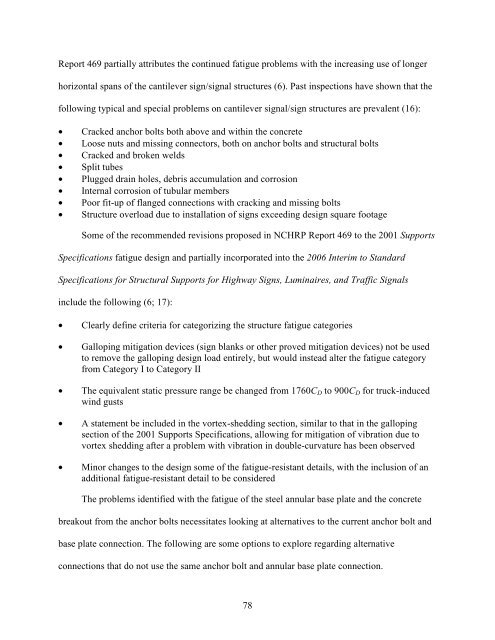Alternative Support Systems for Cantilever - National Transportation ...
Alternative Support Systems for Cantilever - National Transportation ...
Alternative Support Systems for Cantilever - National Transportation ...
Create successful ePaper yourself
Turn your PDF publications into a flip-book with our unique Google optimized e-Paper software.
Report 469 partially attributes the continued fatigue problems with the increasing use of longer<br />
horizontal spans of the cantilever sign/signal structures (6). Past inspections have shown that the<br />
following typical and special problems on cantilever signal/sign structures are prevalent (16):<br />
• Cracked anchor bolts both above and within the concrete<br />
• Loose nuts and missing connectors, both on anchor bolts and structural bolts<br />
• Cracked and broken welds<br />
• Split tubes<br />
• Plugged drain holes, debris accumulation and corrosion<br />
• Internal corrosion of tubular members<br />
• Poor fit-up of flanged connections with cracking and missing bolts<br />
• Structure overload due to installation of signs exceeding design square footage<br />
Some of the recommended revisions proposed in NCHRP Report 469 to the 2001 <strong>Support</strong>s<br />
Specifications fatigue design and partially incorporated into the 2006 Interim to Standard<br />
Specifications <strong>for</strong> Structural <strong>Support</strong>s <strong>for</strong> Highway Signs, Luminaires, and Traffic Signals<br />
include the following (6; 17):<br />
• Clearly define criteria <strong>for</strong> categorizing the structure fatigue categories<br />
• Galloping mitigation devices (sign blanks or other proved mitigation devices) not be used<br />
to remove the galloping design load entirely, but would instead alter the fatigue category<br />
from Category I to Category II<br />
• The equivalent static pressure range be changed from 1760CD to 900CD <strong>for</strong> truck-induced<br />
wind gusts<br />
• A statement be included in the vortex-shedding section, similar to that in the galloping<br />
section of the 2001 <strong>Support</strong>s Specifications, allowing <strong>for</strong> mitigation of vibration due to<br />
vortex shedding after a problem with vibration in double-curvature has been observed<br />
• Minor changes to the design some of the fatigue-resistant details, with the inclusion of an<br />
additional fatigue-resistant detail to be considered<br />
The problems identified with the fatigue of the steel annular base plate and the concrete<br />
breakout from the anchor bolts necessitates looking at alternatives to the current anchor bolt and<br />
base plate connection. The following are some options to explore regarding alternative<br />
connections that do not use the same anchor bolt and annular base plate connection.<br />
78
















